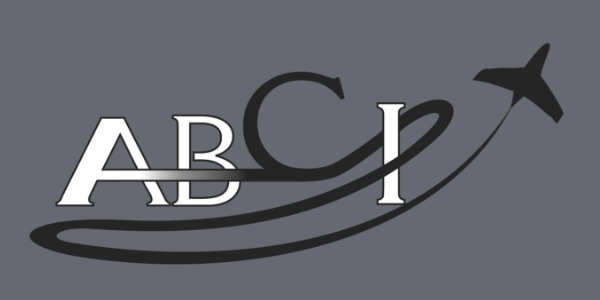Faced with shiny blank new aviation marketing calendar for 2020? Tasked with improving your sales and marketing results in the new year? We’ll help you plan the tasks you need to make 2020 the best sales and marketing results ever.
Transcript – How to Create an Aviation Marketing Calendar for 2020
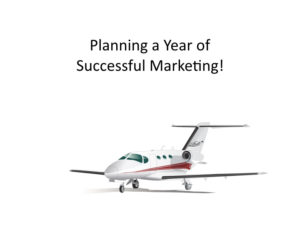 Paula Williams: Welcome to this week’s episode. We are coming up on the end of the year again. How did that happen?
Paula Williams: Welcome to this week’s episode. We are coming up on the end of the year again. How did that happen?
John Williams: I have no idea. Time just seems to fly when you’re having a good time.
Paula Williams: That is true. And we are, so I guess we can’t complain about that. So this is actually an update of episode 62 where we talked about planning a year of marketing at a time.
John Williams: Good grief, that was a long time ago.
Paula Williams: That was a really long time ago, it was like three years ago. Anyway, a long, long time ago.
An Update of Episode 62 – New Tech & Lessons Learned
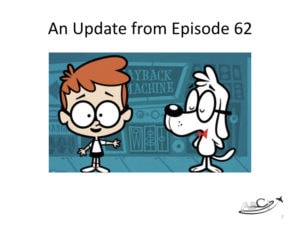 And it’s time to update it because some things have changed and technology has changed. We’ve learned some new things and we’ve learned more about our clients. We’ve learned more about what works for them and so on. So we’re going to update this with some new and better information, right?
And it’s time to update it because some things have changed and technology has changed. We’ve learned some new things and we’ve learned more about our clients. We’ve learned more about what works for them and so on. So we’re going to update this with some new and better information, right?
John Williams: Exactly.
Paula Williams: Okay. And it was a very popular episode as well. So time to-
John Williams: Hopefully.
Paula Williams: Yeah, clear up some things that were a little bit embarrassing about the way that it got outdated, so.
John Williams: [inaudible 00:01:06].
Paula Williams: Right. Okay. So this episode is being brought to you by our shiny new beautiful calendar, right?
John Williams: Oh, I thought you were going to say jet.
Our Aviation Marketing Wall Calendar
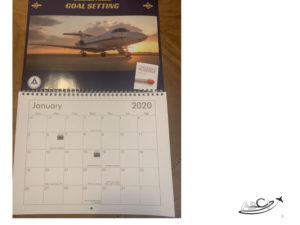 Paula Williams: Well, I wish it was. This is the new thing. This is a wall calendar that you can get from us just by writing to us and telling us that you are a sales or marketing professional in the aviation industry. And there’s a link on our website where you can request this. So we’ll send it to you in the mail. US only preferably. And also you do need to be a sales or marketing professional of some sort, so.
Paula Williams: Well, I wish it was. This is the new thing. This is a wall calendar that you can get from us just by writing to us and telling us that you are a sales or marketing professional in the aviation industry. And there’s a link on our website where you can request this. So we’ll send it to you in the mail. US only preferably. And also you do need to be a sales or marketing professional of some sort, so.
John Williams: Preferably in aviation.
Paula Williams: Yeah, because this is really for you, it’s got all of the aviation shows on it. It’s got important dates on it. It’s really actually only helpful for someone who is in that category, right?
John Williams: Exactly.
Paula Williams: Okay. Now we’re going to tell you how to use it, right? It doesn’t do itself.
John Williams: No?
Paula Williams: Very sad.
John Williams: That’s too bad.
Paula Williams: Exactly.
Eliminate, Automate, Delegate!
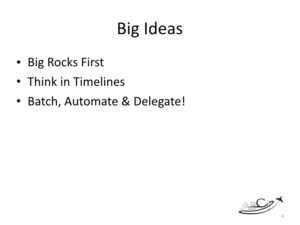 John Williams: And how are we supposed to automate that?
John Williams: And how are we supposed to automate that?
Paula Williams: Well, we’re going to talk about some things that you can automate in the calendar. But you can’t automate your planning process, that is why God made managers, right?
John Williams: Really?
Paula Williams: And founders and CEOs and all those other things, and we are still needed.
John Williams: It’s probably a good thing.
Paula Williams: Yeah, exactly. AI can’t do everything for us.
John Williams: Not yet.
Big Rocks First!
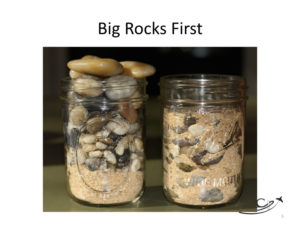 Paula Williams: Exactly. Okay. So the three things we’re going to be talking about today are big rocks first, this is kind of a, Franklin Covey, concept where you plan out your largest and most time consuming events first, and then everything else kind of flows around it. Second thing is working timelines or thinking timelines. And the third thing is eliminate, automate, delegate. If you are using the Tim Ferris.
Paula Williams: Exactly. Okay. So the three things we’re going to be talking about today are big rocks first, this is kind of a, Franklin Covey, concept where you plan out your largest and most time consuming events first, and then everything else kind of flows around it. Second thing is working timelines or thinking timelines. And the third thing is eliminate, automate, delegate. If you are using the Tim Ferris.
John Williams: This says batch.
Paula Williams: Yeah, batch is one thing that I added. I’m differing with Tim Ferris. He has this book, The Four Hour Work Week, which is, the title is a complete joke, but it is a very good book. I don’t know anybody who is successful in any profession who does a four hour work week, do you?
John Williams: No.
Paula Williams: No. But the ideas and the book are actually pretty good and they talk about how to spend your time where you get the most leverage. And so that’s what we’re going to be talking about today so that your next year is going to be a thousand times more productive than you were last year without having a thousand clones of yourself, right?
John Williams: Exactly.
Paula Williams: Okay. Cool. All right, so first thing, this is a concept that I first learned at Franklin Covey when I was working there. They use this image in just about every lecture, in fact, people would walk around with two Mason jars with bags of rocks and sand. I kid you not, this is one of the most powerful demonstrations of what happens to people when they don’t plan their time and their budgets and everything else, right?
John Williams: Yep.
Paula Williams: So if you don’t plan your budget, you’re going to end up frittering your money, $2 here, $2 there, and then wondering where the heck your paycheck went, right?
John Williams: Mm-hmm (affirmative).
Paula Williams: Same thing happens with your time. If you don’t plan your time, you get up in the morning, you check Facebook, you answer the phone, you do a couple of things, and all of a sudden the day’s gone. You have no idea what you did, right?
John Williams: That’s because you didn’t prioritize.
Paula Williams: Right. So we’re going to do this with an entire year where we plan, put the big rocks in the Mason jar first and then you put the smaller rocks in and they’ll fit into those spaces, and then you pour the sand in on top, shake it around a little bit and it will fit into those spaces. So those things like checking your email and answering the phone are not going to consume your entire year this year like they may have last year, right?
John Williams: Exactly.
Paula Williams: Okay, cool.
John Williams: And some people may say that this is a trick of illusion. All I have to do is say try it.
Paula Williams: Right. Basically, for those of you who are not familiar with this trick, you take two equal size Mason jars and two equal volumes of rocks, pebbles and sand, and the one on the left-hand side, they put the sand in first and packed it down real good, then put the smaller rocks in and then built up to the largest rocks on top, and there’s no way they’re going to get those big rocks in after getting all that sand packed in, right?
John Williams: Mm-hmm (affirmative).
Paula Williams: The one on the right, they put the big rocks in first and then the little pebble, shake it around, get it all settled, pour in the sand, shake it around get it all settled. You can pack a lot more in if you put the big things in first, right?
John Williams: Mm-hmm (affirmative).
Paula Williams: And anyone who’s packed the luggage compartment of a caravan with a ton of stuff will understand this as well.
John Williams: This is how you get 10 pounds into a five pound bag.
Paula Williams: Mm-hmm (affirmative). Check your weight and balance, right? Okay. All right, so let’s talk about the big rocks first. Obviously this shows, in the aviation industry are the most time consuming things that we typically do in sales and marketing, right? They often take several days. They take a lot of money. It takes a lot of preparation and planning.
Trade Shows, Events & Major Campaigns are the “Big Rocks” in an Aviation Marketing Calendar
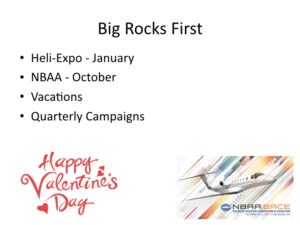 John Williams: A lot of preparatory work and a lot of follow-up.
John Williams: A lot of preparatory work and a lot of follow-up.
Paula Williams: Exactly. So you want to put those on the calendar first because you don’t want to be up against the wall when it’s time to leave for a show having not made any phone calls, not set any appointments, not done the preparatory work with getting the promotional materials and getting your booth in order and all those things that you need to do. So you want to get those things on the calendar first and they’re actually pre-printed for you on this calendar. But there may be some specialty shows that you go to that may not be in here. So if there’s any particular shows that you do want to go to, make sure that those are in there and outlined in red before you do anything else, right?
John Williams: Exactly.
Paula Williams: Okay. There’s also a worksheet that you can download too, to do this all on one page and then transfer it to your bigger calendar, so.
John Williams: We update this every year, so if we find something we missed then this is the culmination of what, eight or nine years?
Paula Williams: Yeah, we’ve been doing a calendar for eight or nine years and every time we add more to it, so.
John Williams: Mm-hmm (affirmative).
Paula Williams: Okay. All right. You also want to plan some campaigns and promotions. So we do a referral campaign every February, which is a great time to do a referral campaign by the way, because it’s still chilly enough that you can send chocolate in the mail without worrying about it, for the most part, unless you’re sending it to Florida. Thank you for Terry for letting us know that you got chocolate soup last year. But anyway, a referral campaign is a really good thing to plan once a year. Valentine’s Day is a great time to do it. It’s something that does require a little bit of preparation and planning. You may want to get some things professionally printed. So, you want to be thinking about this in January, right?
John Williams: And you want to plan for it financially at the first of the year.
Paula Williams: Yeah, so I’ll put it on the calendar and then John, who is our CFO will know Paula is going to be spending hundreds of dollars on chocolate. Not for me, unfortunately, but that happens just about every year, right?
John Williams: Mm-hmm (affirmative), it does actually.
Paula Williams: And you’re going, why are we spending so much money on chocolate? But if we planned it before you’d know.
John Williams: Mm-hmm (affirmative).
Paula Williams: Okay, cool. So our calendar of course has the Heli-Expo in January, Valentine’s Day also happens in January. We need to figure out how to get that to work and maybe delegate some tasks so that those things get sent out while we’re at the show, right?
John Williams: Mm-hmm (affirmative).
Paula Williams: Okay. We’ve got NBAA in October and this is in Orlando this year, so it’s a bit of a-
John Williams: Hike.
Paula Williams: … hike for us in Salt Lake City to Orlando.
John Williams: But we take advantage of that.
Paula Williams: Yeah.
John Williams: We tested it out last year, right?
Paula Williams: Two years ago.
John Williams: Two years ago.
Paula Williams: When we were also in Orlando, we drove from Salt Lake to Orlando.
John Williams: Yeah, but we managed to drive in such a manner to visit almost all of the clients on the Eastern half of the US.
Paula Williams: Mm-hmm (affirmative), which was really cool because a lot of these folks, we had never met in person before. But it was also very time consuming and expensive, so we needed to be cognizant of that and have some backup in the office so that our people were getting taken care of while we were out shaking hands and eating food.
John Williams: Well it really wasn’t that expensive if you consider two airline tickets and a rental car on the other end.
Paula Williams: That’s true.
John Williams: So, we came out pretty close to even.
Paula Williams: Right, exactly. And if you plan these things far enough in advance, you can take advantage of a lot of discounts and things, and not have to pay expediting fees and stuff like that. So your whole year ends up being a lot less expensive than it would otherwise. The other thing that you want to plan in that we hadn’t been doing a very good job of until this year was vacations. In a startup you never take a vacation, right? But we’re getting, our is getting mature enough to the point where we can actually take a couple of days here and there and we’ve got folks to cover for us and we can get away without being a major disruption. And that’s important, right?
John Williams: Actually we took what, eight or nine days recently.
Paula Williams: Yeah, that’s true.
John Williams: Or 10.
Paula Williams: Yeah, we’re just getting back into the office after spending some time. One of our kids graduated from Bootcamp, so we went to Fort Leonard Wood Missouri.
John Williams: And visited with a potential client along the way. But, you know a vacation did good when you get back and you’re trying to find where everything is.
Paula Williams: Right. Figuring out how to work all your equipment and things. So, but seriously, vacations are very important for you and for your folks. If you want to retain good people, you do need a break, right?
John Williams: Mm-hmm (affirmative).
Paula Williams: Okay. So plan those in today.
John Williams: As do they.
Paula Williams: As do they, right. And we’re thinking, the last time we spoke about this topic, we were talking about monthly campaigns. Having a different campaign every month. But after doing that for a few years with a few clients and with ourselves, we’re finding that quarterly campaigns often work better because you can do more preparation, more follow-up, do a more complete thorough job of it. We’ve got a long sales cycle anyway. And then we’re not driving ourselves crazy. And then assuming the campaign works and we end up with a bunch of new clients, we’re not completely overwhelmed because we have to do another campaign the next month, right?
John Williams: Right.
Paula Williams: So this has really helped us think in terms of quarters rather than months.
John Williams: Of course, on the other hand, if you’re a brand new startup, you may want to continue with the monthly’s for a while.
Paula Williams: Yeah. So, it’s just a matter of your cadence of marching, right? If you’re doing the double step, then do the double! Do whatever you have to do for your business. But, if you’re able to slow that down, slow your roll as they say and do higher quality campaigns, then think about doing it that way.
John Williams: Of course.
Paula Williams: And if your campaigns are not getting done at all, you definitely want to slow your roll and think about how to make that happen, because you’re probably not allowing enough time.
John Williams: Exactly.
Paula Williams: Okay. And you’re just making your people crazy. Okay, so this is a map that you’ve seen a million times from us in different podcast episodes and things like that.
Permanent Systems & Temporary Campaigns- You Need Both!
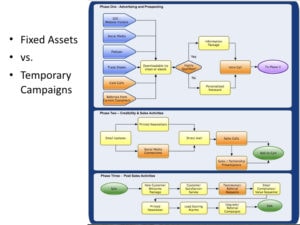 This is a marketing system. So this is the infrastructure that we have in place. We’ve got a website with search engine optimization, we’ve got social media, we’ve got podcasts, we’ve got trade shows, all of those things are kind of fixed assets that we do every year and we’ve got a process around each of them. All of that is pretty much the way it’s supposed to be. Campaigns are things that start and end, right?
This is a marketing system. So this is the infrastructure that we have in place. We’ve got a website with search engine optimization, we’ve got social media, we’ve got podcasts, we’ve got trade shows, all of those things are kind of fixed assets that we do every year and we’ve got a process around each of them. All of that is pretty much the way it’s supposed to be. Campaigns are things that start and end, right?
John Williams: Mm-hmm (affirmative).
Paula Williams: Okay. So the reason for that is because if you don’t put any urgency into the way that you do business, especially in aviation, people will never get around to buying from you.
John Williams: Right.
Paula Williams: So they’ll keep doing whatever they’re doing until something changes that makes them make a move. So they don’t really feel a compelling reason to switch from one system to another or one plane to another or anything else until something breaks or they’re not in compliance legally or you give them some kind of a deadline.
John Williams: Right.
Paula Williams: So-
John Williams: It has to be valid.
Paula Williams: Yeah, exactly. So you want to think in terms of a timeline.
Leverage A Timeline – Don’t Try Doing Everything At Once!
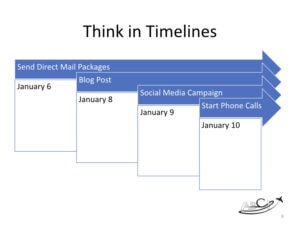 So we’re going to use all these assets, but we’re going to use them in a particular way. So, we’ve got our email lists, we’ve got our podcasts, we’ve got our social media, we’ve got our website. If we think in terms of a timeline, we can send a direct mail package on January 6th, as an example. And then we can write a blog post about that same topic on January 8th, which happens to be a Sunday. And then a social media campaign that launches on Monday. So people have by that time, gotten something in the mail from us. They have possibly seen our blog post and gotten an email because they’re subscribing to our blog. And if you’re not, you should be because it’s really good information. So the blog post or the podcast episode comes out and then they start seeing social ads for the same thing.
So we’re going to use all these assets, but we’re going to use them in a particular way. So, we’ve got our email lists, we’ve got our podcasts, we’ve got our social media, we’ve got our website. If we think in terms of a timeline, we can send a direct mail package on January 6th, as an example. And then we can write a blog post about that same topic on January 8th, which happens to be a Sunday. And then a social media campaign that launches on Monday. So people have by that time, gotten something in the mail from us. They have possibly seen our blog post and gotten an email because they’re subscribing to our blog. And if you’re not, you should be because it’s really good information. So the blog post or the podcast episode comes out and then they start seeing social ads for the same thing.
And then we start making phone calls because that is my least favorite thing to do to a cold audience. So now I’ve got them warmed up with three different things. They’ve got the package, they’ve read the blog posts, or they’ve watched the episode, they’ve seen the social media campaigns. They’re not totally cold when I call them.
John Williams: Yeah. In fact, many of them say, oh yeah, I recognize you from your podcast.
Paula Williams: Exactly. And I know exactly what you want to talk about because I’ve just read that and I just got what you sent in the mail and here it is, so let’s talk about that. And that is a much easier conversation to have than, who are you again? Who are you with, click, which is what everybody does these days because telemarketing is so off
John Williams: All the robocalls are really bad.
Paula Williams: Right, exactly. So you really want to warm people up. If you do a phone call, you want to add that at the end of the list. But you want to put these in an order that makes sense so that you’re doing this in a way that capitalizes on each other and really leverages the time.
John Williams: Yep.
Paula Williams: Right, so that’s kind of timelines and time stacking or marketing stacking, if we want to call it that.
Batch, Organize & Outsource Around our Marketing Lab
 Okay. So batching, automating and outsourcing. In our Marketing Lab we conquer one topic each month. And so for January is goal setting, we do all of our goal setting for the year, ideally in January, so that might be around your keywords that you want to be known for, around your sales goals, your marketing goals, goals for traffic to your website.
Okay. So batching, automating and outsourcing. In our Marketing Lab we conquer one topic each month. And so for January is goal setting, we do all of our goal setting for the year, ideally in January, so that might be around your keywords that you want to be known for, around your sales goals, your marketing goals, goals for traffic to your website.
John Williams: And to expand a little bit, we have a preset agenda monthly, but that’s only in the event that you don’t have a priority you want to talk about.
Paula Williams: Exactly. Of course, the neat thing about planning, and this is like a military thing, this was Eisenhower that said this. Plans are useless, but the act of planning is priceless. It was something along those lines. I’m not sure if I got that exactly right.
John Williams: It’s close.
Paula Williams: But the fact that you have done the planning means that you can then, you have liberty to make another decision if you decide not to execute your plan.
John Williams: He said another well known one, “Failure to plan is planning to fail.”
Paula Williams: Yeah, exactly. So all of that is very true. So, in January we do all of our goal setting unless something precludes that and something comes up that gloms onto her attention more quickly and we have to take advantage of it immediately. February prospecting, so we do a lot of prospecting in February, fill our funnels and we can coast on that for a while, while we do other things. Like in March we work on credibility markers. With each of our clients we go through things that they can do to increase their credibility in their particular niche of aviation.
John Williams: Exactly.
Paula Williams: Right. So that really helps us focus on one thing at a time. When you try to do everything at the same time, you’re not going to be effective.
John Williams: Right.
Paula Williams: So we plan, here are the 12 things we’re going to accomplish this year and we divide that out so that it’s in nice little chunks. Okay, so, we’ve talked about the big rocks first. We’ve talked about thinking and timelines, batching, automating and outsourcing. So automating, automate all the things, right?
John Williams: Well at least as many as you can.
What Can You Automate?
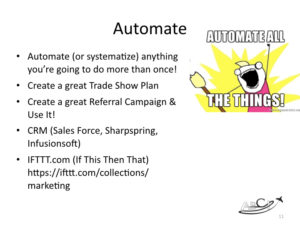 Paula Williams: Right. Okay. There is such a thing as bad automation, we’ve all experienced it. If you’ve ever answered the phone to hear a robot talking to you, that’s really, really bad. Or if you find yourself in an email or a chat loop with a bad chatbot that’s trying to do customer service and not doing a very good job of it.
Paula Williams: Right. Okay. There is such a thing as bad automation, we’ve all experienced it. If you’ve ever answered the phone to hear a robot talking to you, that’s really, really bad. Or if you find yourself in an email or a chat loop with a bad chatbot that’s trying to do customer service and not doing a very good job of it.
John Williams: Yeah. And AI on the phone is getting pretty good and you listened to and you say, yeah, but what I really want to know, and they continue just like you weren’t even there, then you know you’re talking to a robot.
Paula Williams: You’re clearly not listening.
John Williams: And you just hang up on that one.
Paula Williams: Right, exactly. Okay. But what we mean in a lot of cases by automated, and this is something that John and I did when we were working for a bank a million years ago. There was a process that had to happen for tax reporting every year at this bank. And you would not think that this is an emergency because it happens every dang year, right? But it was an emergency every dang year, right?
John Williams: So we fixed it.
Paula Williams: So what we did is we put together a project plan for that kind of reporting. We said, you run this batch, you do this, dah, dah, dah, dah, dah, dah, dah, dah, dah, dah. And we put it into a nice big poster that they hang on the wall-
John Williams: And call it year end processing.
Paula Williams: Year end processing. Not an emergency. Same thing with trade shows, if you go to the same trade show every year, it should not be an emergency.
John Williams: No, because you should have six months before you’ve already got things planned out, starting a list of who you’re going to talk to, who you want to talk to, who’s the competitor, I mean all of those things. And you know what it’s going to cost and you’ve already budgeted for it, et cetera, et cetera.
Paula Williams: Yeah. And we do this in Basecamp. We can do a repeating list. So we do, every time we go to a trade show, we just pop out that list and it says, do you have a booth? Do you need a booth? Are you going to just do appointments? All of those things. So if you have a repeating list that you can just run out there and then check things off as you need to, you’ve already got the contact information for your vendors. You’ve already got the lessons learned in the things that you decided you were never going to do that way again. You were never going to wait this late before you start doing you’re printing, those kinds of things.
John Williams: And you know when you go to buy, rent, lease a booth that you don’t have to find out at the last minute, you mean I have to rent a trashcan too. You already have a list of all these things that you need and you just check them off and submit the request.
Paula Williams: And every time you do this you get better.
John Williams: You absolutely do.
Paula Williams: Right, because you learn new things. So create a trade show plan and save it so the next time you go to a trade show, make sure you save that plan so that you can just pull it out again and start checking stuff off. Whether you do that electronically or in a binder or a notebook, doesn’t matter just-
John Williams: Long as it gets done.
Paula Williams: Yeah. You can do this same thing with a referral campaign. So, if you do the same referral campaign every year, we do Valentine’s Day, it doesn’t have to be that unique to be effective. So, our Valentine’s Day campaign includes a direct mail of some kind. It might be different every year. It includes social media of some kind. It includes some sales letters and some other materials. So we know we have to do the printing, we have to do the, get the supplies, we have to get the postage and all that stuff figured out and we just check off that list every year.
Okay. So some of the things that you can use for this are project management software like Basecamp or Asana or whatever it is that you use, SharpSpring. Not SharpSpring, SharePoint is the other one.
John Williams: SharePoint, yeah.
Paula Williams: Yeah. So there’s project management software that can help you with this or you can do it old school in a notebook, doesn’t matter just as long as you’re doing it. Other things that you can use are a CRM to setup marketing automation tasks. So, if you have that referral campaign and there are a certain set of emails that go with that, you can just pull that out every year-
John Williams: Modify the email.
Paula Williams: Yeah. Change the pictures, change some of the text and you’re already halfway done.
John Williams: Right.
Paula Williams: Okay. You’ve got all the timing figured out, you got it figured out what works. You’ve done ideally-
John Williams: The hard part.
Paula Williams: Yeah, and you’ve ideally measured the results. You know what the open rates were for each of those emails, so you know which ones are going to need work next time and which ones work really well already, perform really well already. So those CRMs, Salesforce, SharpSpring, Infusionsoft, whatever you’ve got, really are helpful for some of these things. Another thing is IFTTT, if this then that, is an automation platform that has a bunch of really cool little applets in there that fire for one reason or another. So, if someone likes your page on Facebook, as an example, or does a cert.
ain action, then you can take it from one system and put it into another. There’s lots of ways that you can use these things to automate those little tasks that drive you crazy and take up a lot of your time because of those little gravel pieces that fill up the jar really quick if you’re not careful.
John Williams: Yep.
How to Outsource & Delegate Safely
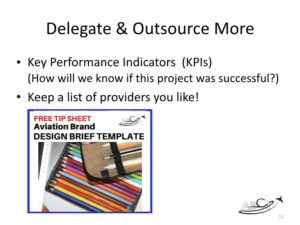 Paula Williams: Okay. Delegate and outsource more. So most-
Paula Williams: Okay. Delegate and outsource more. So most-
John Williams: And outsource doesn’t necessarily mean overseas either.
Paula Williams: No, that can be to an intern from your local college. It can be to your kids, it can be to your business partners and other folks, your team members. So, a lot of us are really afraid to delegate and outsource.
John Williams: It comes with the territory.
Paula Williams: Yeah. Because we’re picky, right? That’s why we started our own company, because we want to do things our own way, right?
John Williams: Yes.
Paula Williams: So what you have to do is setup some key performance indicators. How will ,I know if this was done successfully? So, when I work with one of our web developers I say, what I’m looking for is something that loads in less than two seconds and has these things and is able to do this and doesn’t trip the spam filters and all of the things that I know I need to make sure that that happens. And it drives them crazy, but it sure is nice to know ahead of time rather than going back over and over and over again to have to correct things that are not right. And another thing is to keep a list of providers you like and use them over and over and over again.
John Williams: Yes.
Paula Williams: And we try to be that for our clients.
John Williams: Yes, we do.
Paula Williams: So they come back to us over and over and over again for the tasks that they do. We’ve done this before, it’s not our first rodeo. It was successful last time, but we also measured the results and so we know how we could make it more successful when we do it again.
Okay, so couple of things. The design brief template, if you hand that to a vendor, this is something that you can also get on our tip sheet page on our website. So if you search for aviation marketing tip sheets, you’ll get to our tip sheet page with all of our tips sheets, this being one of them. The design brief, you put your logo in, your fonts, your colors, all of those things, and then it’s easier to delegate. So when you delegate and say, make me a brochure or make me a webpage, or make me a this or that, it’s going to come back looking-
John Williams: Like you want it.
Paula Williams: … a whole lot more likely to be what you want without you having to specify all those details over again.
John Williams: So once you haven’t setup, you take this and you go to Kinko’s or Alpha Graphics, or wherever you want to go and say, this is what I want it to look like. Here’s the data.
Paula Williams: Exactly. Or, yeah, the people that do your trade show booth, the people that do outdoor graphics if you’re doing an event.
John Williams: Or size for a trade show booth.
Paula Williams: Yeah. The people that are doing your T-shirts, anything that you get done, you can hand them this design brief and things will come out looking better than they would otherwise.
John Williams: Exactly.
Download the Aviation Marketing Calendar for 2020 – The Worksheet
(& Request the Printed Wall Calendar, too!)
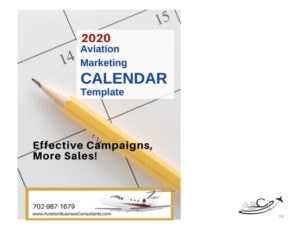 Paula Williams: Okay. So, also when that tip sheet page, you can download our aviation marketing calendar template, which has a neat spreadsheet that you can use to capture all of these ideas and then hang it on your wall next to your printed calendar so that you can see in January we were going to do blah, blah, blah, blah, blah, transfer it to the calendar so you know which days you’re going to do that on. The calendar is such a liberating thing. Seriously, if you don’t plan it, it will … If you don’t run your calendar, your calendar will run you, right?
Paula Williams: Okay. So, also when that tip sheet page, you can download our aviation marketing calendar template, which has a neat spreadsheet that you can use to capture all of these ideas and then hang it on your wall next to your printed calendar so that you can see in January we were going to do blah, blah, blah, blah, blah, transfer it to the calendar so you know which days you’re going to do that on. The calendar is such a liberating thing. Seriously, if you don’t plan it, it will … If you don’t run your calendar, your calendar will run you, right?
John Williams: And That’s not good.
Paula Williams: It is not good. So if you put some time and just a couple of hours into planning 2020, you’re going to feel so much more in control and you’re going to have so much better results than you would otherwise.
John Williams: In fact, we just got off the phone with a client a couple of hours ago that we did exactly that with her.
Paula Williams: Yep, we’re doing this with our clients in office hours this month, and it is so, such a relief for them to have this all planned out and not feel like they have to do everything right now.
John Williams: Exactly.
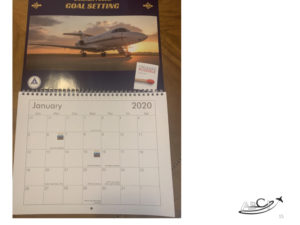 Paula Williams: Because okay, well that’s covered, it’s going to be done in January or it’s going to be done in March. And I don’t have to think about that yet because it fits into a neat spot.
Paula Williams: Because okay, well that’s covered, it’s going to be done in January or it’s going to be done in March. And I don’t have to think about that yet because it fits into a neat spot.
John Williams: Yep.
Paula Williams: Okay. So, go sell more stuff.
John Williams: Yeah, American needs the business, and Mr Ziegler had a good line there.
Paula Williams: Absolutely. Thank you for joining us.
John Williams: And we’ll see you next time.
Paula Williams: Absolutely.
Podcast: Play in new window | Download
Subscribe: Spotify | Amazon Music | RSS
